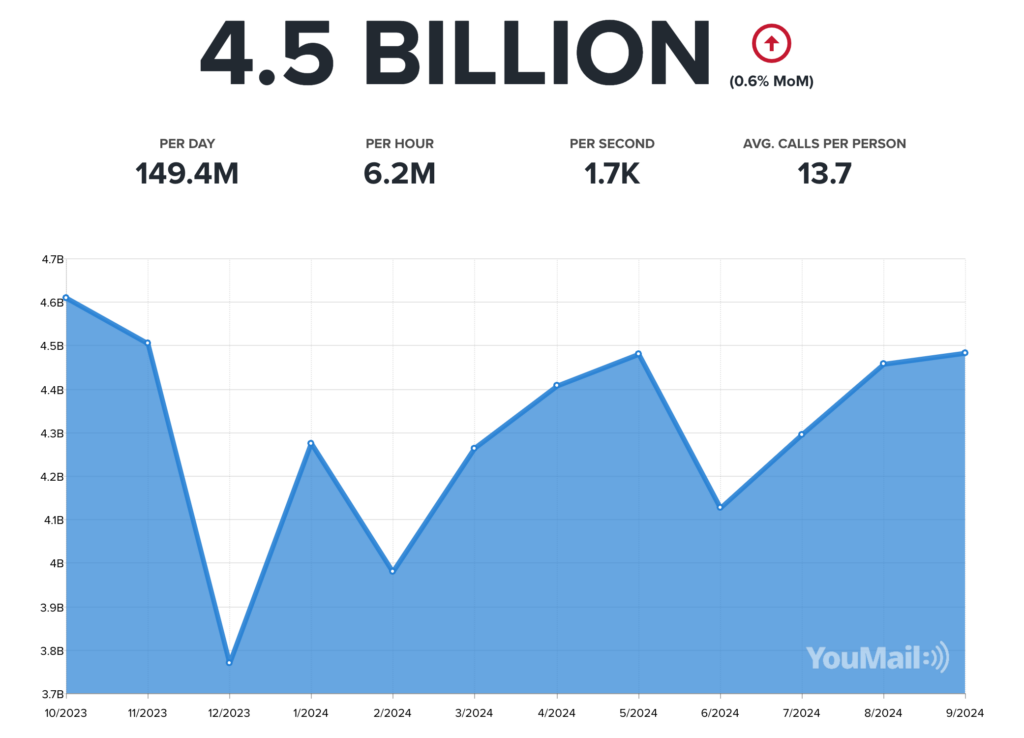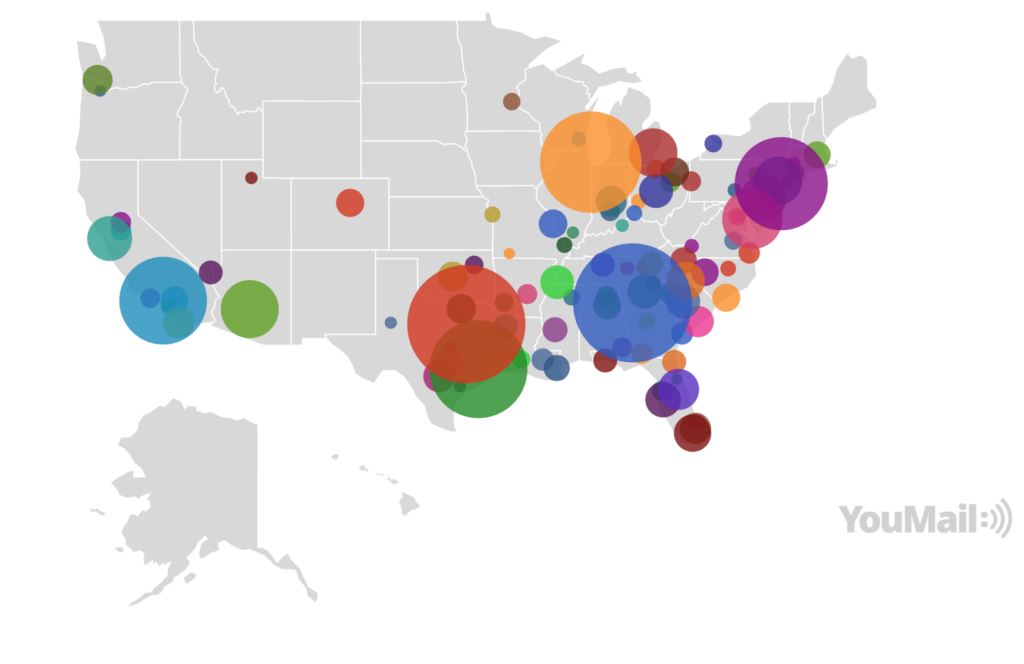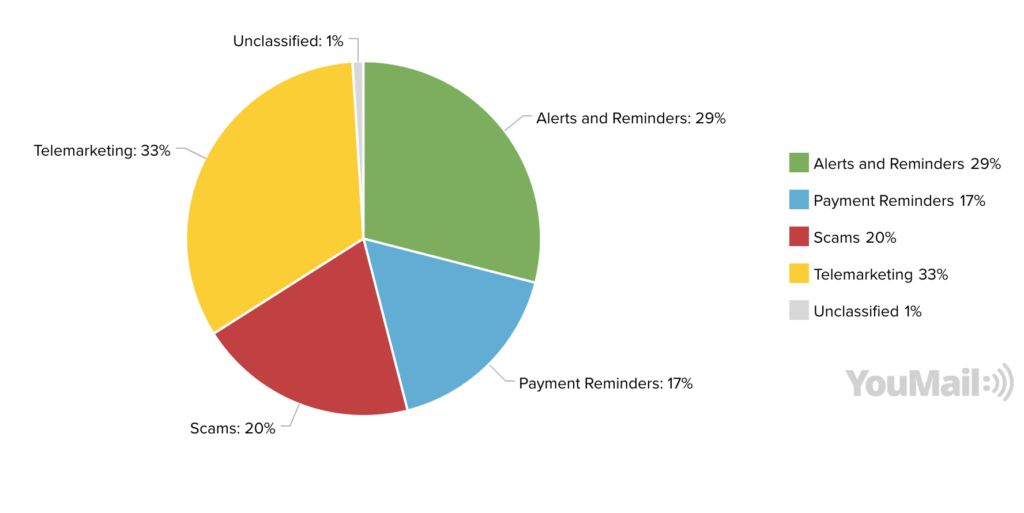In September 2024, robocalls, including spam calls and scam calls continued to surge across the United States, with an estimated 4.5 billion robocalls placed. This flood of unwanted communications is not just an inconvenience—it’s becoming a major concern for consumers, especially as robotexts are also on the rise. In this article, we’ll break down the latest data on robocalls, examine the top cities impacted, and explore how consumers can protect themselves from this relentless wave of spam and scams.
In this article we will cover:
- Nationwide Robocall and Spam Call Overview
- Top 10 Cities Receiving the Most Robocalls
- What’s Driving the MoM Changes?
- Breakdown of Robocall and Scam Categories
- The Rise of Spam Texts and Robo Texts
- Top Area Codes Affected by Robocalls
Nationwide Robocall and Spam Call Overview

The numbers speak for themselves. According the YouMail Robocall Index In September alone:
- 4.5 billion robocalls were placed across the U.S.
- This translates to 149.4 million calls per day, or 6.2 million calls per hour.
- Every second, 1.7K calls are made, with the average American receiving 13.7 spam calls in just one month.
This overwhelming volume of calls includes everything from telemarketing and scam calls to more dangerous scam texts sent by fraudsters looking to deceive. Whether it’s a spam call offering a bogus deal or a scam text attempting to extract personal information, these messages are growing in sophistication and frequency.
Top 10 Cities Receiving the Most Robocalls
Which cities bore the brunt of this deluge of unwanted calls? Here are the top 10 cities hit hardest in September 2024:

| Rank | City | State | Estimated Calls Received | % Change MoM |
| 1 | Atlanta | GA | 157,370,200 | +2% |
| 2 | Dallas | TX | 156,328,600 | +2% |
| 3 | Chicago | IL | 134,243,600 | 0% |
| 4 | Houston | TX | 129,561,600 | +4% |
| 5 | New York City | NY | 123,140,200 | +3% |
| 6 | Los Angeles | CA | 116,026,400 | +1% |
| 7 | Baltimore | MD | 79,611,600 | 0% |
| 8 | Phoenix | AZ | 76,757,700 | -3% |
| 9 | Detroit | MI | 64,413,000 | -1% |
| 10 | Newark | NJ | 63,938,900 | 0% |
Leading the nation, Atlanta received over 157 million robocalls in September, followed closely by Dallas and Chicago. Houston saw a significant 4% increase, with telemarketing and scam calls playing a large role in these spikes.
What’s Driving the MoM Changes?
The month-over-month (MoM) changes in call volumes can often be traced to regional factors. Houston’s increase, for example, is likely fueled by a rise in telemarketing campaigns and scam calls. Meanwhile, Phoenix saw a 3% decrease, possibly due to increased enforcement against illegal robocalls.
Scam calls continue to be a major issue, especially as fraudsters use new techniques to bypass call-blocking technologies and target consumers with more convincing schemes. Many of these calls attempt to mimic legitimate businesses or government agencies, making it harder for people to differentiate between a real call and a scam call.
Breakdown of Robocall and Scam Categories
In September 2024, telemarketing calls made up the largest share of robocalls at 33%, followed closely by scam calls at 20%. Here’s a full breakdown of robocall categories:

- Telemarketing: 33%
- Scams: 20%
- Alerts and Reminders: 29%
- Payment Reminders: 17%
- Unclassified: 1%
While telemarketing calls are often legitimate, they can be a gateway to scams. Scam calls are particularly dangerous because they use social engineering tactics to trick people into revealing sensitive information. For example, some scammers impersonate IRS agents or banks, leading victims to believe they owe money or need to verify their accounts.
The Rise of Spam Texts and Robo Texts
In addition to robocalls, spam texts and robo texts are increasingly becoming a problem. These unsolicited messages often appear to come from legitimate sources, but clicking on the links they contain can expose you to malware or phishing attacks. Scam texts have become especially prevalent during elections, with political texts flooding consumers’ phones.
If you’ve been receiving scam texts or robo texts, it’s important to report them to the proper authorities and block the numbers. Both the FCC and FTC provide guidance on how to protect yourself from unwanted texts and calls.
Top Area Codes Affected by Robocalls
In addition to tracking cities, we can also examine the top area codes impacted by robocalls. The 404 area code in Atlanta led the way, with Houston’s 832 area code close behind:
| Rank | Area Code | City | State | Estimated Calls Received | % Change MoM |
| 1 | 404 | Atlanta | GA | 63,315,600 | 0% |
| 2 | 832 | Houston | TX | 59,010,900 | +3% |
| 3 | 214 | Dallas | TX | 54,686,400 | +2% |
| 4 | 678 | Atlanta | GA | 47,790,500 | +2% |
These area codes are among the most targeted by telemarketing, spam calls, and scam texts, with millions of unwanted communications directed at residents each month.
How to Protect Yourself from Robocalls, Spam Calls, and Scam Texts
With telemarketing, scam calls, and robo texts continuing to invade our lives, there are tools available to help protect yourself. Apps like YouMail are designed to block unwanted calls and filter out spam calls and scam texts. YouMail’s services make it easier to manage and reduce the number of robocalls reaching your phone.
In addition, you can report any suspicious calls or texts to the FTC or FCC, who are working to combat the rise of illegal robocalls and scam texts.
Conclusion: Stay Proactive
With robocalls and scam texts showing no signs of slowing down, it’s more important than ever to take steps to protect yourself. Whether you’re dealing with telemarketing, scam calls, or spam texts, using call-blocking apps and reporting suspicious activity can make a difference. Download the YouMail app today to start blocking unwanted calls and take back control of your phone.
Download YouMail and instantly stop spam calls, texts, and voicemail.





